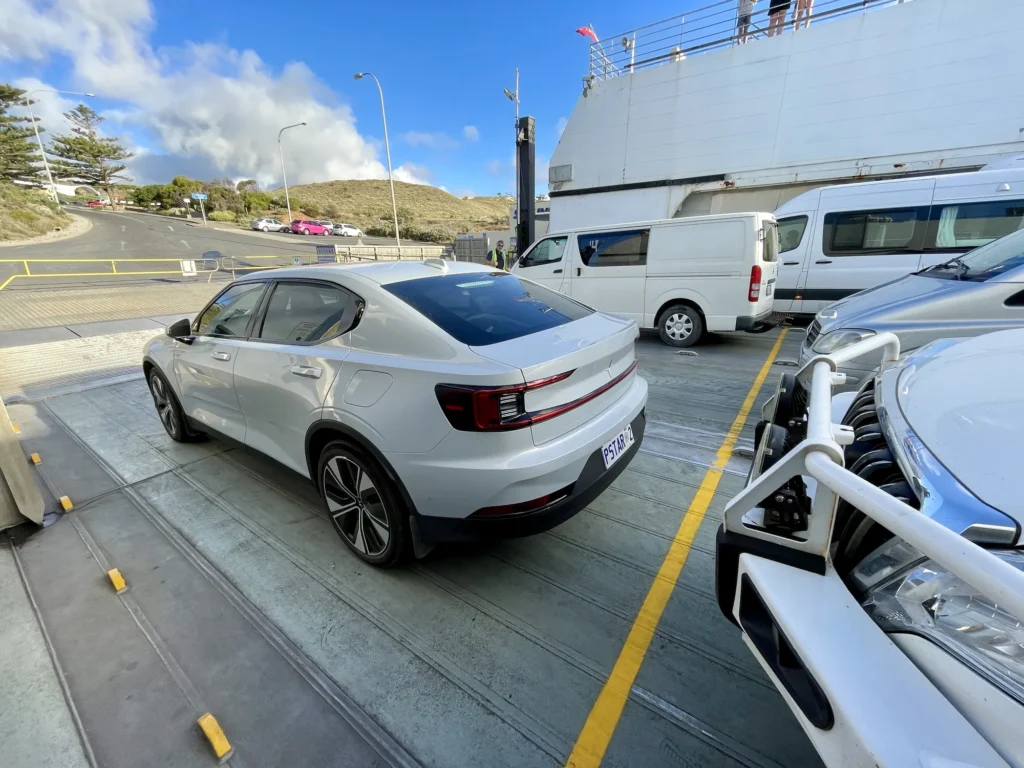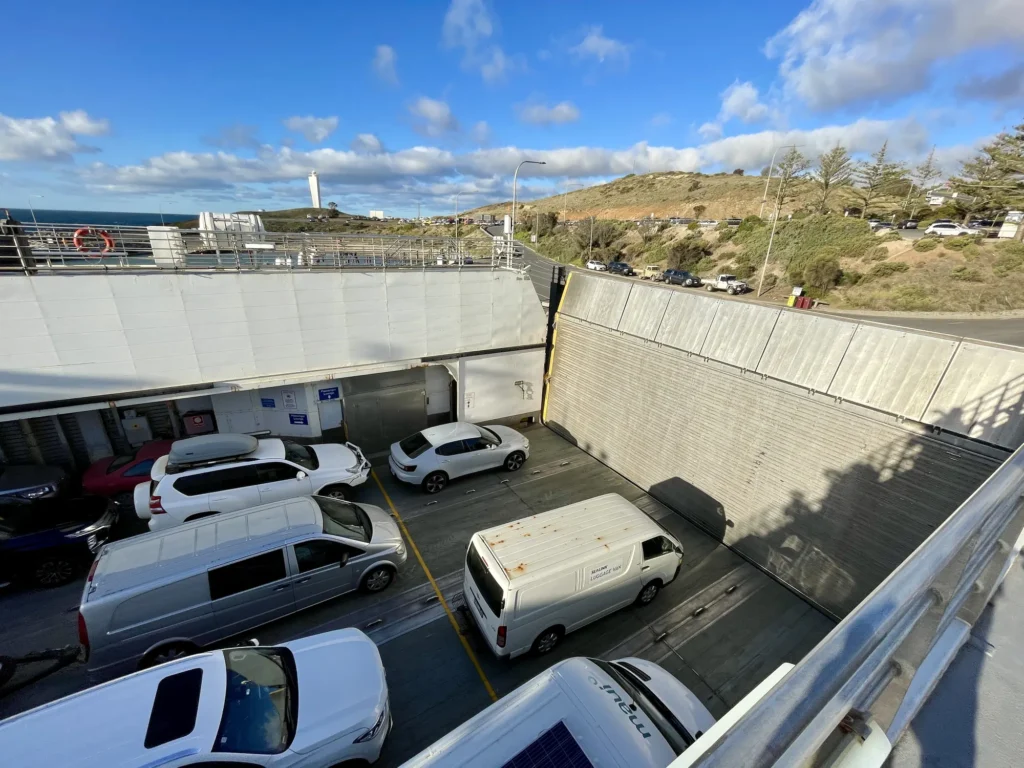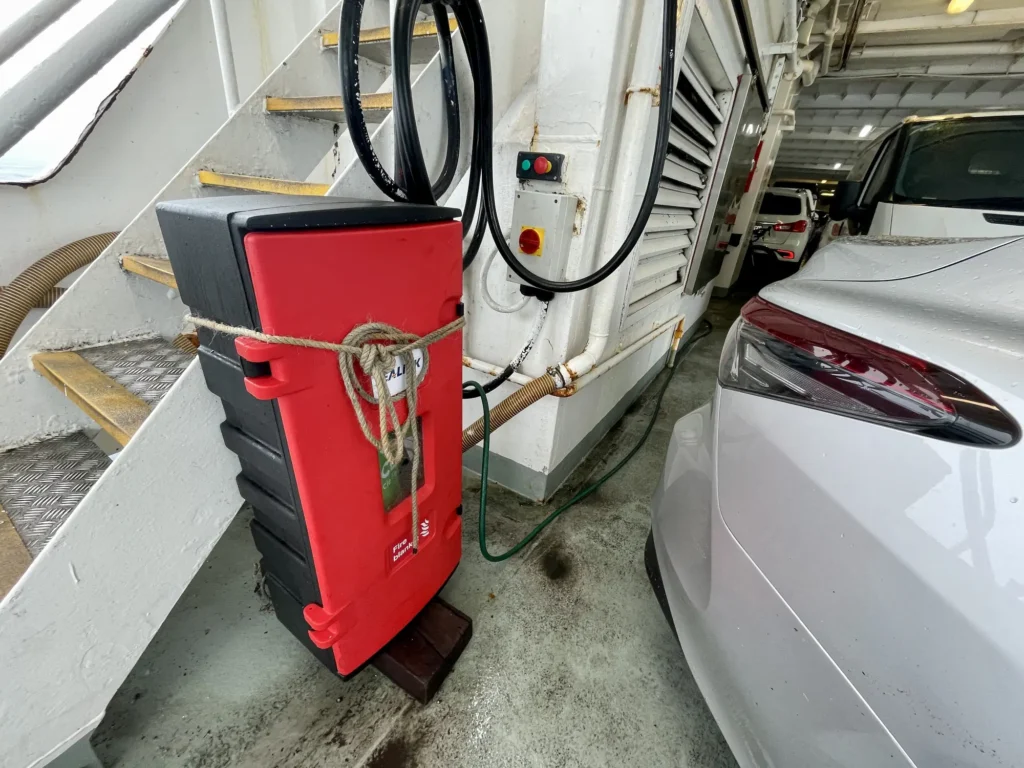The following article is written by Stan Gorton, a South Australian EV enthusiast who lives on Kangaroo Island with his dog Twiggy and a MY24 Polestar 2 long-range single motor.

SeaLink has introduced new procedures for electric vehicles being transported to Kangaroo Island on its two ferries.
These include a pre-boarding inspection and temperature check “to identify and mitigate battery-related risks” for all electric vehicles and hybrids.
Battery Electric vehicles and hybrid vehicles have also been disallowed from specific sailings carrying fuel and other dangerous goods.
And SeaLink is also establishing specific guidelines for electronic devices like e-scooters, e-bikes and e-skateboards, including declaration at check-in and designated onboard stowage.
In an email to subscribers, SeaLink stated the procedures were as per the recommendations in safety alert issued by the Australian Maritime Safety Authority in October 2023, the email stated:
“SeaLink has assessed the risks associated with transporting electric and hybrid vehicles and taken steps to implement specific procedures in the prevention, detection and mitigation of fire incidents involving these vehicles”
SeaLink also stated in its email that passengers are not allowed to remain in vehicles during transit, although this was allowed during COVID to encourage distancing, and had previously been discouraged.

The new measures may be well intentioned but needed to be backed up by real world data and risk assessment, according to Emma Sutfcliffe, chief executive of EV FireSafe.
“Let’s have a data driven approach and an ongoing discussion to make things as safe as possible while getting rid of the hysteria,” she said. “We need to take a sensible approach to it.”
EV FireSafe is a private company that received seed funding from the Australian Department of Defence to research electric vehicle high voltage battery fires and emergency response.
She said it was important that SeaLink understood what it was trying to accomplish by taking measures such as temperature checks of car batteries.
And it needed to follow well-thought-out procedures such as how to fight a vehicle fire, as well as staying up to date with any vehicle recalls.
There have only ever been six confirmed EV fires in Australia to date.
Four of these were related to external, non-related fires or arson, and there was only one instance was a battery fire related to damage from a collision and another single instance caused by road debris that pierced a battery back.
EV FireSafe’s initial research findings, based on global EV battery fires from 2010-2020, indicate a 0.0012 per cent chance of a passenger electric vehicle battery catching fire, compared to a 0.1 per cent chance of an ICE vehicle catching fire.
In other words, internal combustion engined or ICE cars are much more likely to catch fire.
EDITOR: In my opinion the only good part of the new rules is making sure that hybrid cars, electric bikes, scooters etc are transported in safer places onboard.
Unlike pure battery electric cars/trucks/motorbikes, hybrid cars small escooters hover boards etc are all actually proven to be more likely to catch on fire.
If you read the tabloid Press you’d think there were EV battery fires occurring everyday! However this is far from accurate, watch the video interview below with Emma Sutcliffe from evfiresafe.com
As an operational firefighter herself in Australia, Emma and her team have unprecedented access to front line emergencies, and this podcast is a fascinating look at what they are doing to tackle misinformation and the many unfounded claims pushed by those who are opposed to the electrification of ground transport and the move away from fossil fuels.
A view from the EV front seat
As an island resident and EV owner, and given the statistics of ICE vs EV, I do worry the SeaLink electric vehicle policies might needlessly discourage EV ownership or visitation for Kangaroo Island.
I would quickly say, the benefits of owning an EV far outweigh the very minor inconvenience if any inconvenience these measures have.
While I understand the thinking behind the policy, my biggest gripes are having my car doused in saltwater at the back of the boat and also being banned from certain sailings.
Also blaming EVs for not letting people sit in cars is jarring, when this has been an issue for crew regardless of EVs alleged fire risks.
EV FireSafe confirmed there had only ever one EV-related fire on a ferry or marine vessel, only one!
This single case was on a Scandinavian ferry in 2010 and involved a homemade modified car. The rest is disinformation.
They’ve even started DC charging EVs on ferries, specifically the Öresundslinjen ferries in Denmark/Sweden.
Even AMSA’s own publicity using an image of the car carrier Fremantle Roads on fire is irresponsible, as that fire was not proven to be caused by EVs.
According to the International Union of Marine Insurance :
“Our paper draws on a body of scientific research which demonstrates that fires in battery EVs are not more dangerous than fires in conventional vehicles, nor are they more frequent. Although statistics continue to be gathered, they currently estimate that, in general, there are fewer fires from EVs compared with fires from conventional vehicles when driven over the same distance.”
Seems to me like some of the Australian regulations are misguided and an overreaction as other countries don’t do it.
And also I might ask why are SeaLink’s two new ferries, due to commence service in early 2025, not electric powered?
I did ask SeaLink once and they brushed it off saying it was not possible/practical for this use case, but now there is an electric ferry that allows charging at the same time!
SA’s peak motoring body, the RAA has promised to get back to use with its views on the SeaLink policy.

In other and much better EV news for South Australia and Kangaroo Island, the RAA confirmed progress was made on the island’s first rapid 150kw charger.
EV charging program director Andrew Howard said the RAA charging site slated for Lloyd Collins Reserve carpark in Penneshaw was in the final stages of council approval.
And was set to begin construction in February to come online by mid 2024.
Meanwhile on the even bigger picture, EV drivers as well as those concerned about climate change and energy self-sufficiency, are still wondering why it was taking so long for Australia to put in place basic national fuel efficiency standards.
Australia and Russia are now the only countries without these important measures, the lack of which are now placing the country at a distinct disadvantage.
Surely industries it’s not that difficult to protect farming and heavy transport industries are protected while bringing in standards for light transport that stop Australia being a dumping ground for gas guzzlers placing all motorists at a disadvantage.
Federal Member for Mayo, Rebekha Sharkie said the federal government had previously announced that fuel standards legislation would be introduced in 2023, however this did not occur.
Ms Sharkie said:
“The Guardian recently reported that Minister King indicated the standards would “definitely” start in 2024 with a spokesperson advising that developing the best model for Australia was ‘complex’ “
“We can’t answer for the government but it is difficult to understand why it has taken so long.”

Leave a Reply